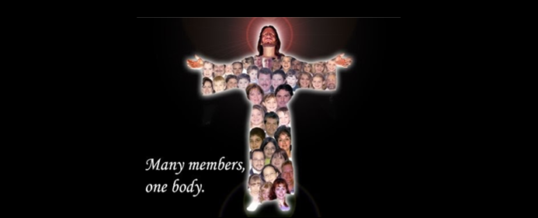
If you have ever accompanied a person approaching their own death, you know the words they share with you are among the most important words you will ever hear from them. When someone is withing hours or days of death, what preoccupies their hearts and minds tends not to be about last night’s Blue Jays game or the price of broccoli. They want to make things right. It’s their last chance to say what they always wanted to say. They speak about forgiveness, or gratitude, or their fears or regrets, or of “going to meet their Maker”—heart stuff.
Jesus was no different. He also had a farewell speech, and it spans five chapters in the Gospel of John (Jn. 13:31-17:26). One of the last things he said to his Apostles before his imminent death was, “Father, just as you are in me and I am in you, so they also be one in us,” (Jn. 17:21). Speaking from his heart of hearts, Jesus’ great desire was that we would all be one.
Let’s face it, we are not all one. Just look at the evening news, if you can tough it out for an entire hour, and you will see how divided we are. Just ponder riffs in your own family, and you will notice how not everyone, nor everything, is one.
We may not have much control over many of the divisions in the outside world, but we can make an effort to be one when we gather for Sunday Eucharist. If we cannot be one in our singing, praying, greeting, and body language during Mass, there’s little hope it will spread outside of the halls of worship into the larger world.
Good liturgy calls for a unified posture. In the parish grouping of Saint Elizabeth of the Trinity, the unifying posture for the entire Eucharistic Prayer is that we stand (It may be different in your parish grouping). “We are the Body of Christ,” and that’s not just a saying or a theological concept that has no ramifications for our lives or for our Sunday worship. If St. Paul were to drop in on our Eucharistic celebrations, he would probably ask the same question he posed to the people in Corinth, “Has Christ been divided?” (1 Cor. 1:13). When some people are standing and others are kneeling during the Eucharistic Prayer, I have to conclude that perhaps Christ is divided—that there is no credence in the belief of one Lord, one Spirit, one Church, and one baptism. Everyone is just doing their own thing. The Church’s liturgy is never an expression of an individual’s personal piety, and it is certainly not an expression of self-righteousness (“I’ll show these people what real worship should be about!”). Everything is symbolic in the Mass; nothing is just done for expediency. If that’s true, then even our body language communicates something.
In the last five years in particular, all the churches that make up our archdiocese have seen a wonderful influx of people from various parts of the world. Look around and you will notice people from the Philippines, South Korea, Indonesia, South America, Africa, and elsewhere. You are a blessing to the Church, an expression of the Church’s richness. However, I challenge you, and everyone else, to be one with the community you worship with. If your desire is to be one with the community you worship with, and that community stands during the Eucharistic Prayer, you stand as well. If your desire is to be one with the worshipping community, and that community kneels at certain points during the Eucharistic Prayer, you kneel as well. If your desire is to one with the worshipping community, and that community stands on its heads and coughs nickels, you stand on your head and cough nickels. Always strive to be one with the community you are worshipping with. Unity must trump all other concerns, even if we think everyone around us is doing it wrong.
I’ve visited St. Peter’s Basilica in Rome. I’ve also visited St. John Lateran Church in Rome (the mother church of all churches in the world), and numerous churches and basilicas all over Europe. One of the things I’ve noticed is that none of them have fixed pews or kneelers. Pews and kneelers came very late in the Church’s history of worship. Maybe they had a better grasp of “uniformity of posture,” of “togetherness” than we have.
My point is, “when in Rome, do as the Romans do.” It not only provides for good liturgy, but it also fulfills Jesus’ dying desire, “that they all be one, Father, as I am in you, and you are in me.”
Fr. Phil Mulligan
JUN
2023

About the Author: